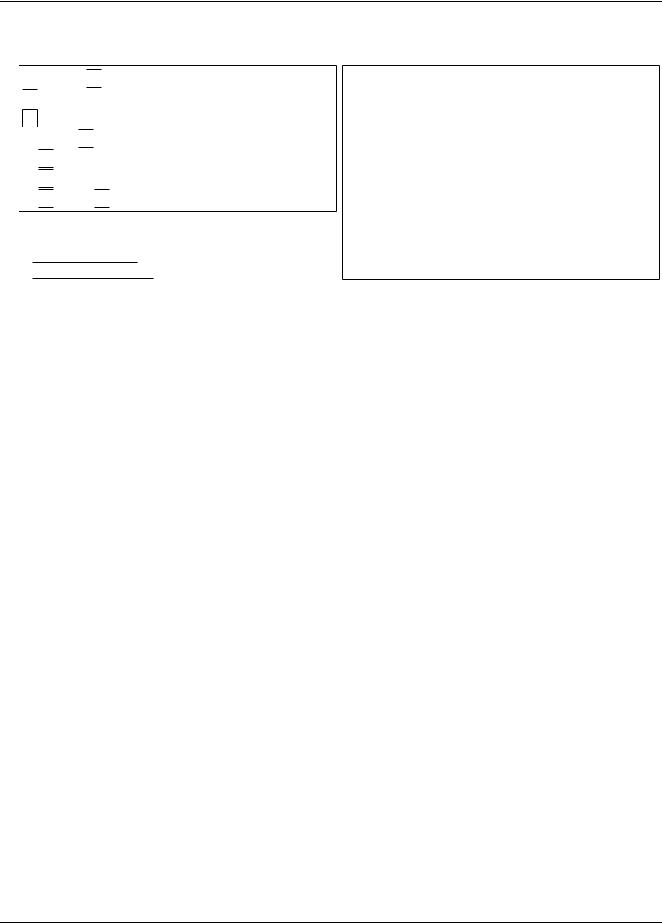
- •Table of Contents
- •Chapter 1. Introduction
- •1.1. Goals
- •1.2. Prior Art
- •1.3. Relation to XML
- •1.4. Terminology
- •Chapter 2. Preview
- •2.1. Collections
- •2.2. Structures
- •2.3. Scalars
- •2.4. Tags
- •2.5. Full Length Example
- •Chapter 3. Processing YAML Information
- •3.1. Processes
- •3.1.1. Represent
- •3.1.2. Serialize
- •3.1.3. Present
- •3.1.4. Parse
- •3.1.5. Compose
- •3.1.6. Construct
- •3.2. Information Models
- •3.2.1. Representation Graph
- •3.2.1.1. Nodes
- •3.2.1.2. Tags
- •3.2.1.3. Nodes Comparison
- •3.2.2. Serialization Tree
- •3.2.2.1. Keys Order
- •3.2.2.2. Anchors and Aliases
- •3.2.3. Presentation Stream
- •3.2.3.1. Node Styles
- •3.2.3.2. Scalar Formats
- •3.2.3.3. Comments
- •3.2.3.4. Directives
- •3.3. Loading Failure Points
- •3.3.1. Well-Formed and Identified
- •3.3.2. Resolved
- •3.3.3. Recognized and Valid
- •3.3.4. Available
- •Chapter 4. Syntax
- •4.1. Characters
- •4.1.1. Character Set
- •4.1.2. Character Encoding
- •4.1.3. Indicator Characters
- •4.1.4. Line Break Characters
- •4.1.5. Miscellaneous Characters
- •4.1.6. Escape Sequences
- •4.2. Syntax Primitives
- •4.2.1. Production Parameters
- •4.2.2. Indentation Spaces
- •4.2.3. Comments
- •4.2.4. Separation Spaces
- •4.2.5. Ignored Line Prefix
- •4.2.6. Line Folding
- •4.3. YAML Character Stream
- •4.3.1. Directives
- •4.3.1.2.1. Tag Prefixes
- •4.3.1.2.2. Tag Handles
- •4.3.2. Document Boundary Markers
- •4.3.3. Documents
- •4.3.4. Complete Stream
- •4.4. Nodes
- •4.4.1. Node Anchors
- •4.4.2. Node Tags
- •4.4.3. Node Content
- •4.4.4. Alias Nodes
- •4.4.5. Complete Nodes
- •4.4.5.1. Flow Nodes
- •4.4.5.2. Block Nodes
- •4.5. Scalar Styles
- •4.5.1. Flow Scalar Styles
- •4.5.1.1. Double Quoted
- •4.5.1.2. Single Quoted
- •4.5.1.3. Plain
- •4.5.2. Block Scalar Header
- •4.5.2.1. Block Style Indicator
- •4.5.2.2. Block Indentation Indicator
- •4.5.2.3. Block Chomping Indicator
- •4.5.3. Block Scalar Styles
- •4.5.3.1. Literal
- •4.5.3.2. Folded
- •4.6. Collection Styles
- •4.6.1. Sequence Styles
- •4.6.1.1. Flow Sequences
- •4.6.1.2. Block Sequences
- •4.6.2. Mapping Styles
- •4.6.2.1. Flow Mappings
- •4.6.2.2. Block Mappings
- •Terms Index

Chapter 4. Syntax
Following are the BNF productions defining the syntax of YAML character streams. To make this chapter easier to follow, production names use Hungarian-style notation:
e- |
A production matching no characters. |
c- |
A production matching one or more characters starting and ending with a special (non-space) character. |
b- |
A production matching a single line break. |
nb- |
A production matching one or more characters starting and ending with a non-break character. |
s- |
A production matching one or more characters starting and ending with a space character. |
ns- |
A production matching one or more characters starting and ending with a non-space character. |
X-Y- |
A production matching a sequence of one or more characters, starting with an X- character and ending |
|
with a Y- character. |
l- |
A production matching one or more lines (shorthand for s-b-). |
X+, X-Y+ |
A production as above, with the additional property that the indentation level used is greater than the |
|
specified n parameter. |
Productions are generally introduced in a “bottom-up” order; basic productions are specified before the more complex productions using them. Examples accompanying the productions list display sample YAML text side-by-side with equivalent YAML text using only flow collections and double quoted scalars. For improved readability, the equivalent YAML text uses the “!!seq”, “!!map” and “!!str” shorthands instead of the verbatim “!<tag:yaml.org,2002:seq>”, “!<tag:yaml.org,2002:map>” and “!<tag:yaml.org,2002:str>” forms. These types are used to resolve all untagged nodes, except for a few examples that use the “!!int” and “!!float” types.
4.1. Characters
4.1.1. Character Set
YAML streams use the printable subset of the Unicode character set. On input, a YAML processor must accept all printable ASCII characters, the space, tab, line break, and all Unicode characters beyond #x9F. On output, a YAML processor must only produce these acceptable characters, and should also escape all non-printable Unicode characters. The allowed character range explicitly excludes the surrogate block #xD800-#xDFFF, DEL #x7F, the C0 control block #x0-#x1F, the C1 control block #x80-#x9F, #xFFFE and #xFFFF. Any such characters must be presented using escape sequences.
[1] c-printable ::= |
|
#x9 | #xA | #xD | [#x20-#x7E] |
/* |
8 bit */ |
||
|
| |
#x85 | [#xA0-#xD7FF] | [#xE000-#xFFFD] /* |
16 |
bit |
*/ |
|
|
| |
[#x10000-#x10FFFF] |
/* |
32 |
bit |
*/ |
20
XSL• FO
RenderX

Syntax
4.1.2. Character Encoding
All characters mentioned in this specification are Unicode code points. Each such code point is written as one or more octets depending on the character encoding used. Note that in UTF-16, characters above #xFFFF are written as four octets, using a surrogate pair. A YAML processor must support the UTF-16 and UTF-8 character encodings. If a character stream does not begin with a byte order mark (#FEFF), the character encoding shall be UTF-8. Otherwise it shall be either UTF-8, UTF-16 LE or UTF-16 BE as indicated by the byte order mark. On output, it is recommended that a byte order mark should only be emitted for UTF-16 character encodings. Note that the UTF-32 encoding is explicitly not supported. For more information about the byte order mark and the Unicode character encoding schemes see the Unicode FAQ [http://www.unicode.org/unicode/faq/utf_bom.html].
[2]c-byte-order-mark ::= #xFEFF
In the examples, byte order mark characters are displayed as “ ”.
Example 4.1. Byte Order Mark
# Comment only. |
# |
This stream contains no |
|
# |
documents, only comments. |
Legend: |
|
|
c-byte-order-mark |
|
|
Example 4.2. Invalid Byte Order Mark
# |
Invalid use of BOM |
ERROR: |
# inside a |
A BOM must not appear |
|
# |
document. |
inside a document. |
4.1.3. Indicator Characters
Indicators are characters that have special semantics used to describe the structure and content of a YAML document.
•A “-” denotes a blocks equence entry.
[3]c-sequence-entry ::= “-”
•A “?” denotes a mapping key.
[4]c-mapping-key ::= “?”
•A “:” denotes a mapping value.
[5]c-mapping-value ::= “:”
21
XSL• FO
RenderX

Syntax
Example 4.3. Block Structure Indicators
sequence :
: 
 -
-  one
one
- two
mapping :
: 
 ?
?  sky
sky
 :
:  blue
blue
 ?
?  sea
sea  :
:  green
green
Legend:
 c-sequence-entry
c-sequence-entry
 c-mapping-key
c-mapping-key
 c-mapping-value
c-mapping-value
•A “,” ends a flow collection entry.
[6]c-collect-entry ::= “,”
•A “[” starts a flow sequence.
[7]c-sequence-start ::= “[”
•A “]” ends a flow sequence.
[8]c-sequence-end ::= “]”
•A “{” starts a flow mapping.
[9]c-mapping-start ::= “{”
•A “}” ends a flow mapping.
[10] c-mapping-end ::= “}”
%YAML 1.1
---
!!map {
?!!str "sequence" : !!seq [
!!str "one", !!str "two"
],
?!!str "mapping"
:!!map {
?!!str "sky" : !!str "blue",
?!!str "sea" : !!str "green",
}
}
22
XSL• FO
RenderX

|
|
|
|
Syntax |
||
Example 4.4. Flow Collection Indicators |
|
|
||||
sequence: [ |
one , |
two , |
] |
|
%YAML 1.1 |
|
mapping: { |
sky: blue , |
sea: green } |
--- |
|||
!!map { |
||||||
|
|
|
|
|
||
Legend: |
|
|
|
|
? !!str "sequence" |
|
|
|
|
|
: !!seq [ |
||
c-sequence-start |
c-sequence-end |
|
||||
|
!!str "one", !!str "two" |
|||||
c-mapping-start |
c-mapping-end |
|
||||
|
], |
|||||
|
|
|
|
|
||
c-collect-entry |
? !!str "mapping" |
|
|
|
: !!map { |
|
? !!str "sky" : !!str "blue", |
|
? !!str "sea" : !!str "green", |
|
} |
|
} |
• A “ #” denotes a comment. |
|
[11] c-comment ::= “#” |
|
Example 4.5. Comment Indicator
 #
#  Comment only.
Comment only.
Legend:
 c-comment
c-comment
•A “&” denotes a node's anchor property.
[12] c-anchor ::= “&”
•A “*” denotes an alias node.
[13] c-alias ::= “*”
•A “!” denotes a node's tag.
[14] c-tag ::= “!”
#This stream contains no
#documents, only comments.
Example 4.6. Node Property Indicators
anchored: ! local & anchor value |
%YAML 1.1 |
|
alias: * anchor |
--- |
|
!!map { |
||
|
||
Legend: |
? !!str "anchored" |
|
: !local &A1 "value", |
||
c-anchor |
||
? !!str "alias" |
||
c-alias |
||
: *A1, |
||
c-tag |
||
} |
||
|
23
XSL• FO
RenderX

Syntax
•A “|” denotes a literal block scalar.
[15] c-literal ::= “|”
•A “>” denotes a folded block scalar.
[16] c-folded ::= “>”
Example 4.7. Block Scalar Indicators
literal:  |
|  text
text
folded:  >
>  text
text
Legend:
 c-literal
c-literal
 c-folded
c-folded
•A “'” surrounds a single quoted flow scalar.
[17] c-single-quote ::= “'”
•A “"” surrounds a double quoted flow scalar.
[18] c-double-quote ::= “"”
%YAML 1.1
---
!!map {
?!!str "literal" : !!str "text\n",
?!!str "folded" : !!str "text\n",
}
Example 4.8. Quoted Scalar Indicators
single:  '
'  text
text '
' 
double:  "
"  text
text "
" 
Legend:
 c-single-quote
c-single-quote
 c-double-quote
c-double-quote
•A “%” denotes a directive line.
[19] c-directive ::= “%”
%YAML 1.1
---
!!map {
?!!str "double" : !!str "text",
?!!str "single" : !!str "text",
}
24
XSL• FO
RenderX
